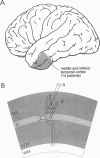Abstract
The primate temporal cortex has been demonstrated to play an important role in visual memory and pattern recognition. It is of particular interest to investigate whether activity-dependent modification of synaptic efficacy, a presumptive mechanism for learning and memory, is present in this cortical region. Here we address this issue by examining the induction of synaptic plasticity in surgically resected human inferior and middle temporal cortex. The results show that synaptic strength in the human temporal cortex could undergo bidirectional modifications, depending on the pattern of conditioning stimulation. High frequency stimulation (100 or 40 Hz) in layer IV induced long-term potentiation (LTP) of both intracellular excitatory postsynaptic potentials and evoked field potentials in layers II/III. The LTP induced by 100 Hz tetanus was blocked by 50-100 microM DL-2-amino-5-phosphonovaleric acid, suggesting that N-methyl-D-aspartate receptors were responsible for its induction. Long-term depression (LTD) was elicited by prolonged low frequency stimulation (1 Hz, 15 min). It was reduced, but not completely blocked, by DL-2-amino-5-phosphonovaleric acid, implying that some other mechanisms in addition to N-methyl-DL-aspartate receptors were involved in LTD induction. LTD was input-specific, i.e., low frequency stimulation of one pathway produced LTD of synaptic transmission in that pathway only. Finally, the LTP and LTD could reverse each other, suggesting that they can act cooperatively to modify the functional state of cortical network. These results suggest that LTP and LTD are possible mechanisms for the visual memory and pattern recognition functions performed in the human temporal cortex.
Full text
PDF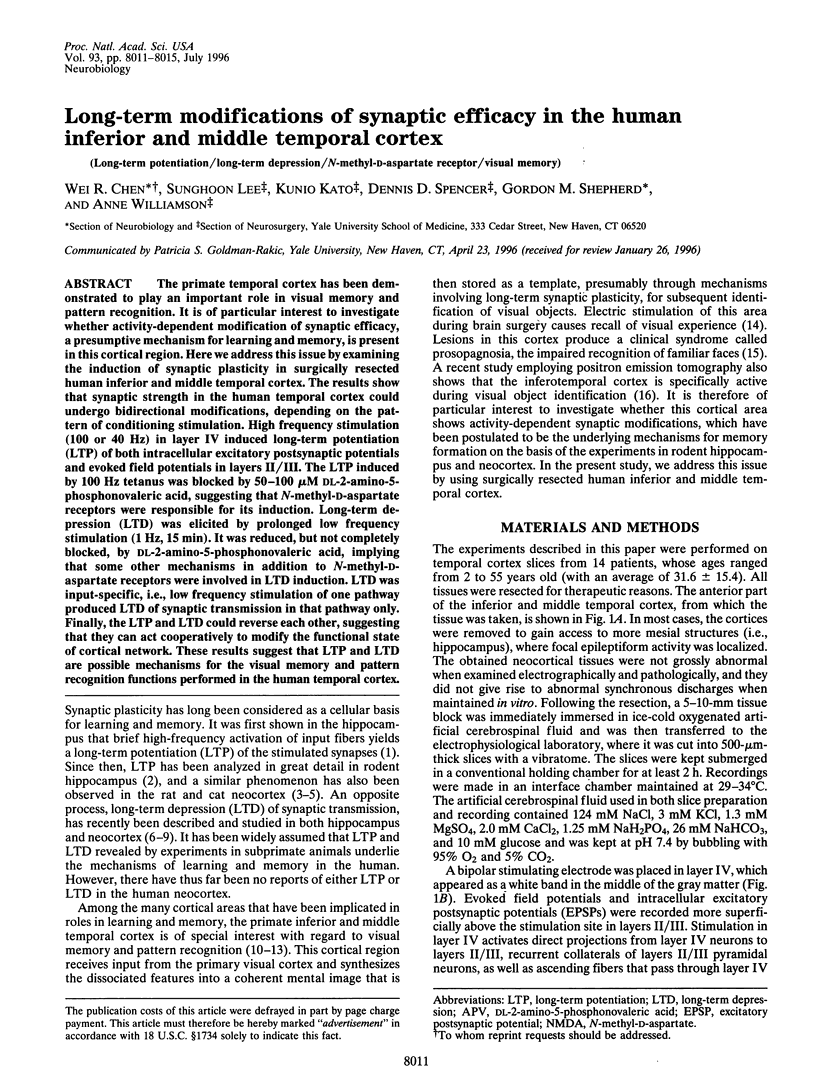
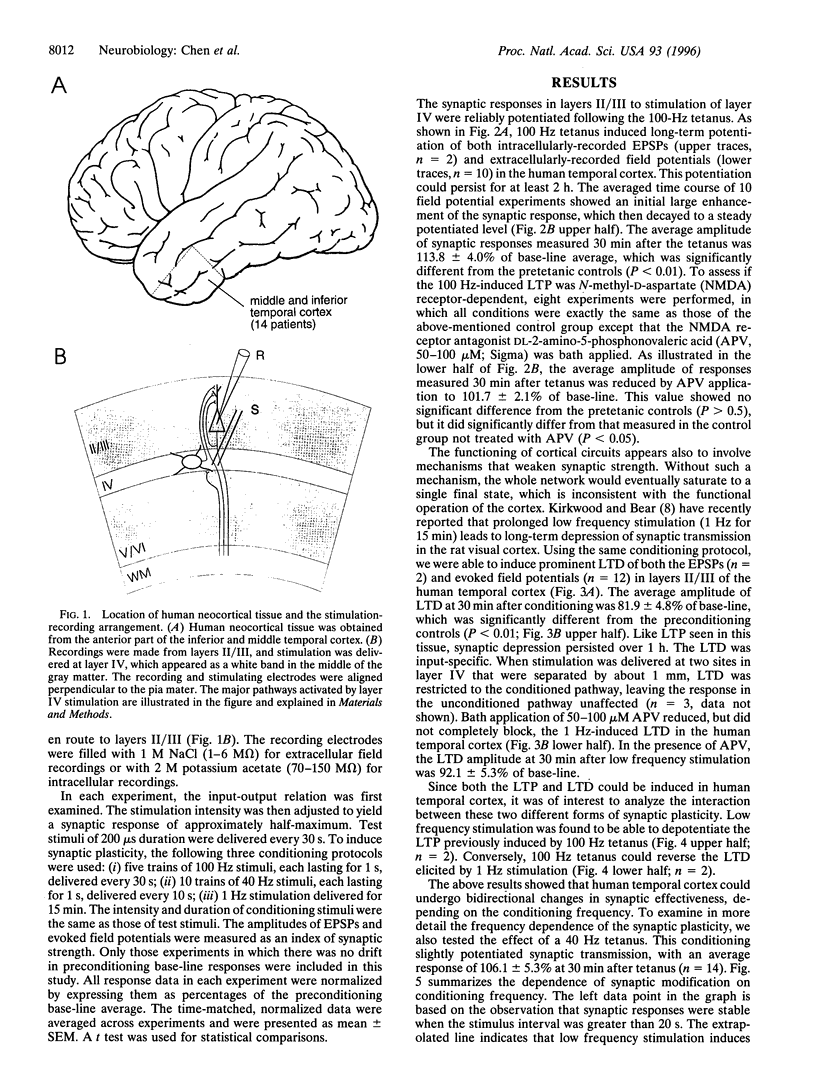
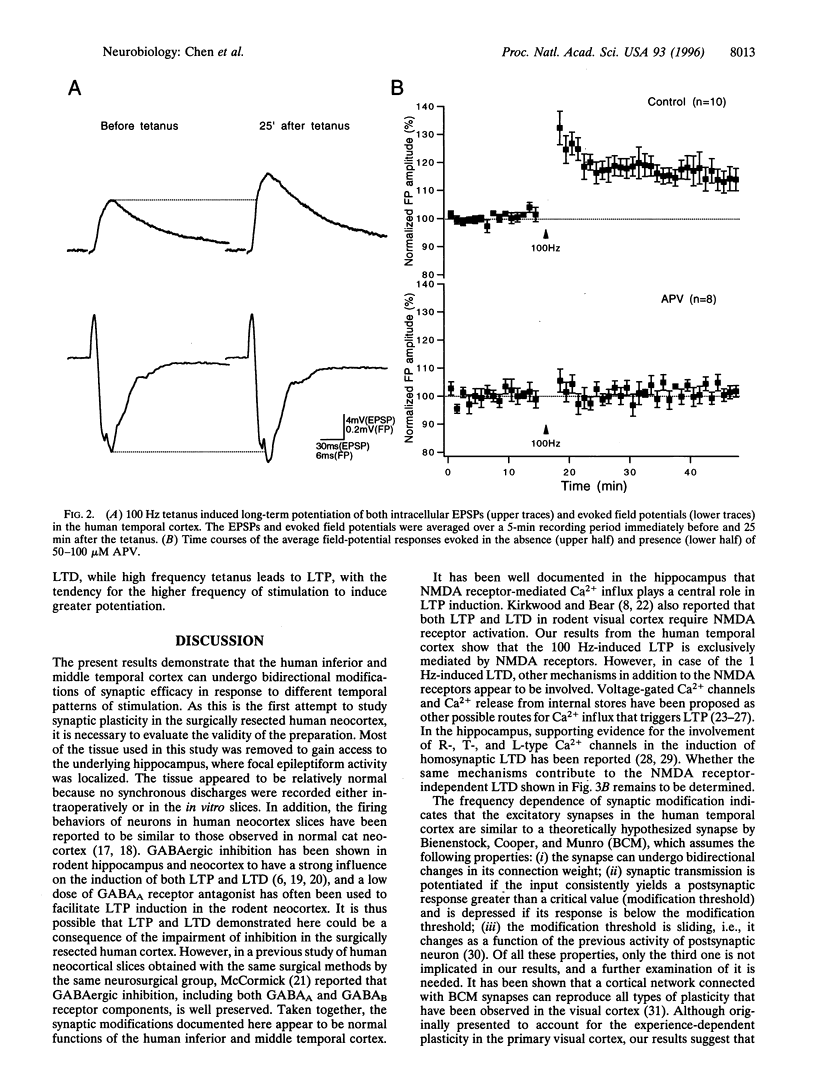
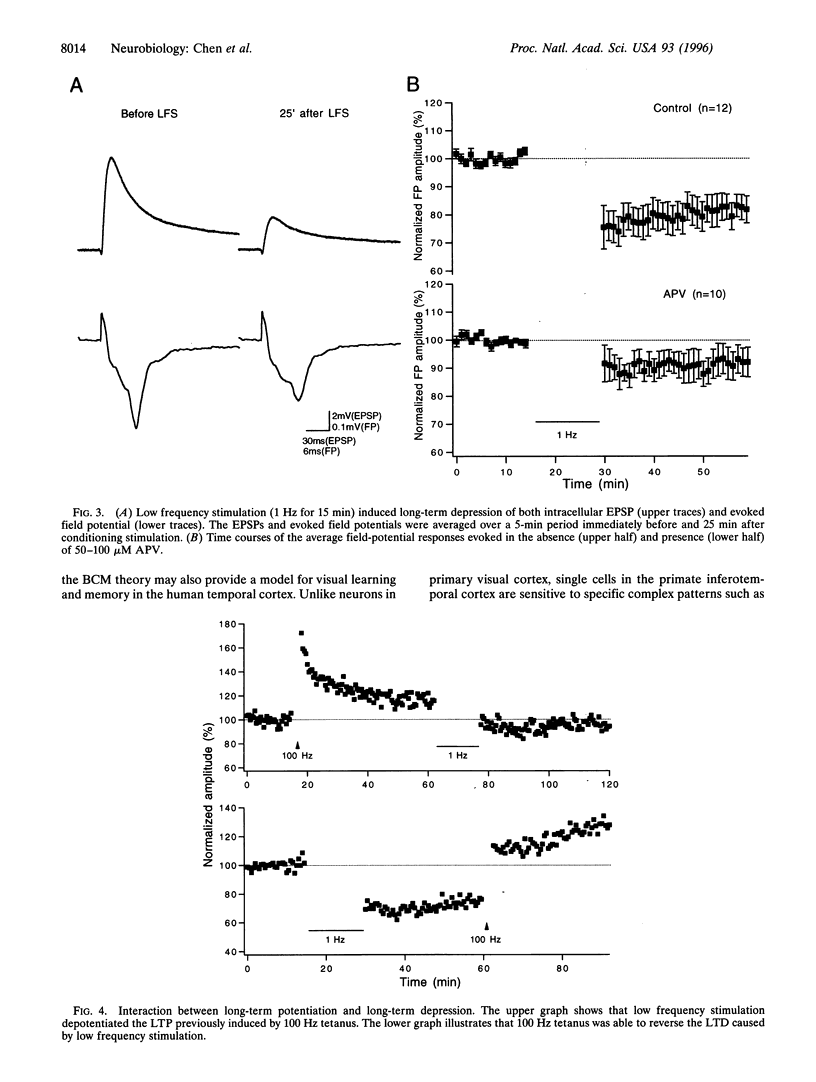
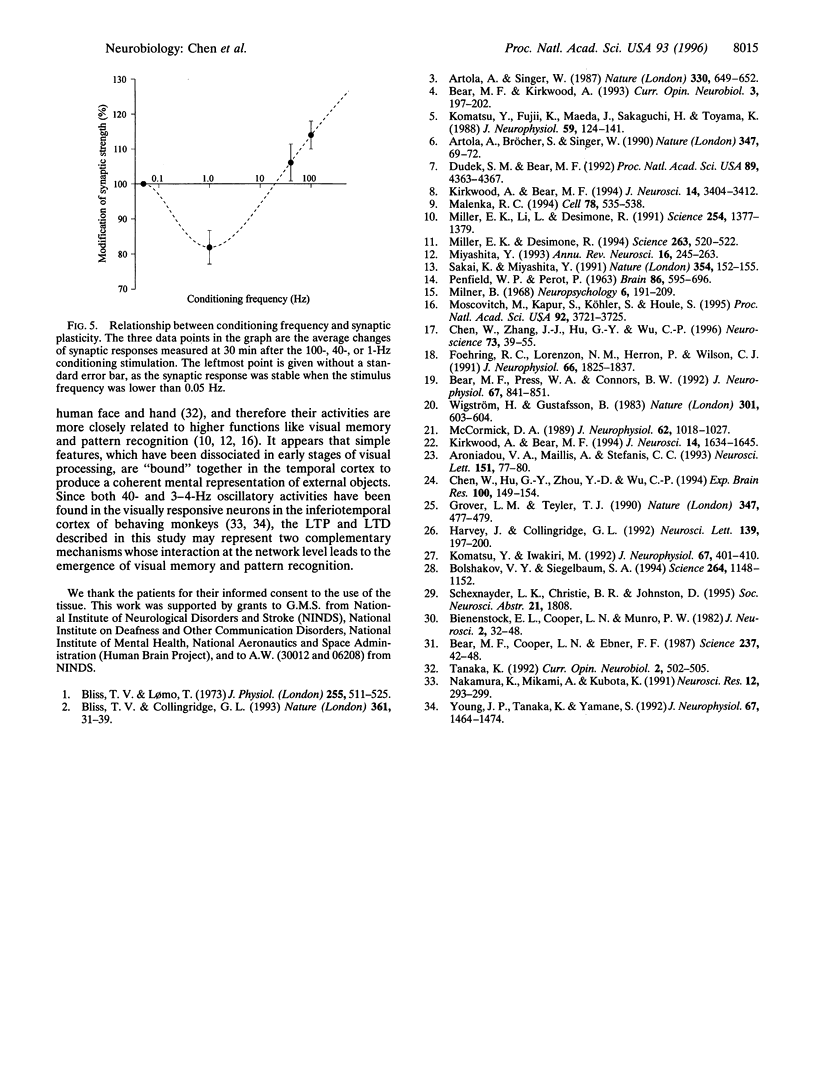
Images in this article
Selected References
These references are in PubMed. This may not be the complete list of references from this article.
- Aroniadou V. A., Maillis A., Stefanis C. C. Dihydropyridine-sensitive calcium channels are involved in the induction of N-methyl-D-aspartate receptor-independent long-term potentiation in visual cortex of adult rats. Neurosci Lett. 1993 Mar 5;151(1):77–80. doi: 10.1016/0304-3940(93)90050-u. [DOI] [PubMed] [Google Scholar]
- Artola A., Bröcher S., Singer W. Different voltage-dependent thresholds for inducing long-term depression and long-term potentiation in slices of rat visual cortex. Nature. 1990 Sep 6;347(6288):69–72. doi: 10.1038/347069a0. [DOI] [PubMed] [Google Scholar]
- Artola A., Singer W. Long-term potentiation and NMDA receptors in rat visual cortex. Nature. 1987 Dec 17;330(6149):649–652. doi: 10.1038/330649a0. [DOI] [PubMed] [Google Scholar]
- Bear M. F., Cooper L. N., Ebner F. F. A physiological basis for a theory of synapse modification. Science. 1987 Jul 3;237(4810):42–48. doi: 10.1126/science.3037696. [DOI] [PubMed] [Google Scholar]
- Bear M. F., Kirkwood A. Neocortical long-term potentiation. Curr Opin Neurobiol. 1993 Apr;3(2):197–202. doi: 10.1016/0959-4388(93)90210-p. [DOI] [PubMed] [Google Scholar]
- Bear M. F., Press W. A., Connors B. W. Long-term potentiation in slices of kitten visual cortex and the effects of NMDA receptor blockade. J Neurophysiol. 1992 Apr;67(4):841–851. doi: 10.1152/jn.1992.67.4.841. [DOI] [PubMed] [Google Scholar]
- Bienenstock E. L., Cooper L. N., Munro P. W. Theory for the development of neuron selectivity: orientation specificity and binocular interaction in visual cortex. J Neurosci. 1982 Jan;2(1):32–48. doi: 10.1523/JNEUROSCI.02-01-00032.1982. [DOI] [PMC free article] [PubMed] [Google Scholar]
- Bliss T. V., Collingridge G. L. A synaptic model of memory: long-term potentiation in the hippocampus. Nature. 1993 Jan 7;361(6407):31–39. doi: 10.1038/361031a0. [DOI] [PubMed] [Google Scholar]
- Bolshakov V. Y., Siegelbaum S. A. Postsynaptic induction and presynaptic expression of hippocampal long-term depression. Science. 1994 May 20;264(5162):1148–1152. doi: 10.1126/science.7909958. [DOI] [PubMed] [Google Scholar]
- Chen W., Hu G. Y., Zhou Y. D., Wu C. P. Two mechanisms underlying the induction of long-term potentiation in motor cortex of adult cat in vitro. Exp Brain Res. 1994;100(1):149–154. doi: 10.1007/BF00227287. [DOI] [PubMed] [Google Scholar]
- Chen W., Zhang J. J., Hu G. Y., Wu C. P. Electrophysiological and morphological properties of pyramidal and nonpyramidal neurons in the cat motor cortex in vitro. Neuroscience. 1996 Jul;73(1):39–55. doi: 10.1016/0306-4522(96)00009-7. [DOI] [PubMed] [Google Scholar]
- Dudek S. M., Bear M. F. Homosynaptic long-term depression in area CA1 of hippocampus and effects of N-methyl-D-aspartate receptor blockade. Proc Natl Acad Sci U S A. 1992 May 15;89(10):4363–4367. doi: 10.1073/pnas.89.10.4363. [DOI] [PMC free article] [PubMed] [Google Scholar]
- Foehring R. C., Lorenzon N. M., Herron P., Wilson C. J. Correlation of physiologically and morphologically identified neuronal types in human association cortex in vitro. J Neurophysiol. 1991 Dec;66(6):1825–1837. doi: 10.1152/jn.1991.66.6.1825. [DOI] [PubMed] [Google Scholar]
- Grover L. M., Teyler T. J. Two components of long-term potentiation induced by different patterns of afferent activation. Nature. 1990 Oct 4;347(6292):477–479. doi: 10.1038/347477a0. [DOI] [PubMed] [Google Scholar]
- Harvey J., Collingridge G. L. Thapsigargin blocks the induction of long-term potentiation in rat hippocampal slices. Neurosci Lett. 1992 May 25;139(2):197–200. doi: 10.1016/0304-3940(92)90551-h. [DOI] [PubMed] [Google Scholar]
- Kirkwood A., Bear M. F. Hebbian synapses in visual cortex. J Neurosci. 1994 Mar;14(3 Pt 2):1634–1645. doi: 10.1523/JNEUROSCI.14-03-01634.1994. [DOI] [PMC free article] [PubMed] [Google Scholar]
- Kirkwood A., Bear M. F. Homosynaptic long-term depression in the visual cortex. J Neurosci. 1994 May;14(5 Pt 2):3404–3412. doi: 10.1523/JNEUROSCI.14-05-03404.1994. [DOI] [PMC free article] [PubMed] [Google Scholar]
- Komatsu Y., Fujii K., Maeda J., Sakaguchi H., Toyama K. Long-term potentiation of synaptic transmission in kitten visual cortex. J Neurophysiol. 1988 Jan;59(1):124–141. doi: 10.1152/jn.1988.59.1.124. [DOI] [PubMed] [Google Scholar]
- Komatsu Y., Iwakiri M. Low-threshold Ca2+ channels mediate induction of long-term potentiation in kitten visual cortex. J Neurophysiol. 1992 Feb;67(2):401–410. doi: 10.1152/jn.1992.67.2.401. [DOI] [PubMed] [Google Scholar]
- Malenka R. C. Synaptic plasticity in the hippocampus: LTP and LTD. Cell. 1994 Aug 26;78(4):535–538. doi: 10.1016/0092-8674(94)90517-7. [DOI] [PubMed] [Google Scholar]
- McCormick D. A. GABA as an inhibitory neurotransmitter in human cerebral cortex. J Neurophysiol. 1989 Nov;62(5):1018–1027. doi: 10.1152/jn.1989.62.5.1018. [DOI] [PubMed] [Google Scholar]
- Miller E. K., Desimone R. Parallel neuronal mechanisms for short-term memory. Science. 1994 Jan 28;263(5146):520–522. doi: 10.1126/science.8290960. [DOI] [PubMed] [Google Scholar]
- Miller E. K., Li L., Desimone R. A neural mechanism for working and recognition memory in inferior temporal cortex. Science. 1991 Nov 29;254(5036):1377–1379. doi: 10.1126/science.1962197. [DOI] [PubMed] [Google Scholar]
- Miyashita Y. Inferior temporal cortex: where visual perception meets memory. Annu Rev Neurosci. 1993;16:245–263. doi: 10.1146/annurev.ne.16.030193.001333. [DOI] [PubMed] [Google Scholar]
- Moscovitch C., Kapur S., Köhler S., Houle S. Distinct neural correlates of visual long-term memory for spatial location and object identity: a positron emission tomography study in humans. Proc Natl Acad Sci U S A. 1995 Apr 25;92(9):3721–3725. doi: 10.1073/pnas.92.9.3721. [DOI] [PMC free article] [PubMed] [Google Scholar]
- Nakamura K., Mikami A., Kubota K. Unique oscillatory activity related to visual processing in the temporal pole of monkeys. Neurosci Res. 1991 Oct;12(1):293–299. doi: 10.1016/0168-0102(91)90119-j. [DOI] [PubMed] [Google Scholar]
- PENFIELD W., PEROT P. THE BRAIN'S RECORD OF AUDITORY AND VISUAL EXPERIENCE. A FINAL SUMMARY AND DISCUSSION. Brain. 1963 Dec;86:595–696. doi: 10.1093/brain/86.4.595. [DOI] [PubMed] [Google Scholar]
- Sakai K., Miyashita Y. Neural organization for the long-term memory of paired associates. Nature. 1991 Nov 14;354(6349):152–155. doi: 10.1038/354152a0. [DOI] [PubMed] [Google Scholar]
- Tanaka K. Inferotemporal cortex and higher visual functions. Curr Opin Neurobiol. 1992 Aug;2(4):502–505. doi: 10.1016/0959-4388(92)90187-p. [DOI] [PubMed] [Google Scholar]
- Wigström H., Gustafsson B. Facilitated induction of hippocampal long-lasting potentiation during blockade of inhibition. Nature. 1983 Feb 17;301(5901):603–604. doi: 10.1038/301603a0. [DOI] [PubMed] [Google Scholar]
- Young M. P., Tanaka K., Yamane S. On oscillating neuronal responses in the visual cortex of the monkey. J Neurophysiol. 1992 Jun;67(6):1464–1474. doi: 10.1152/jn.1992.67.6.1464. [DOI] [PubMed] [Google Scholar]



